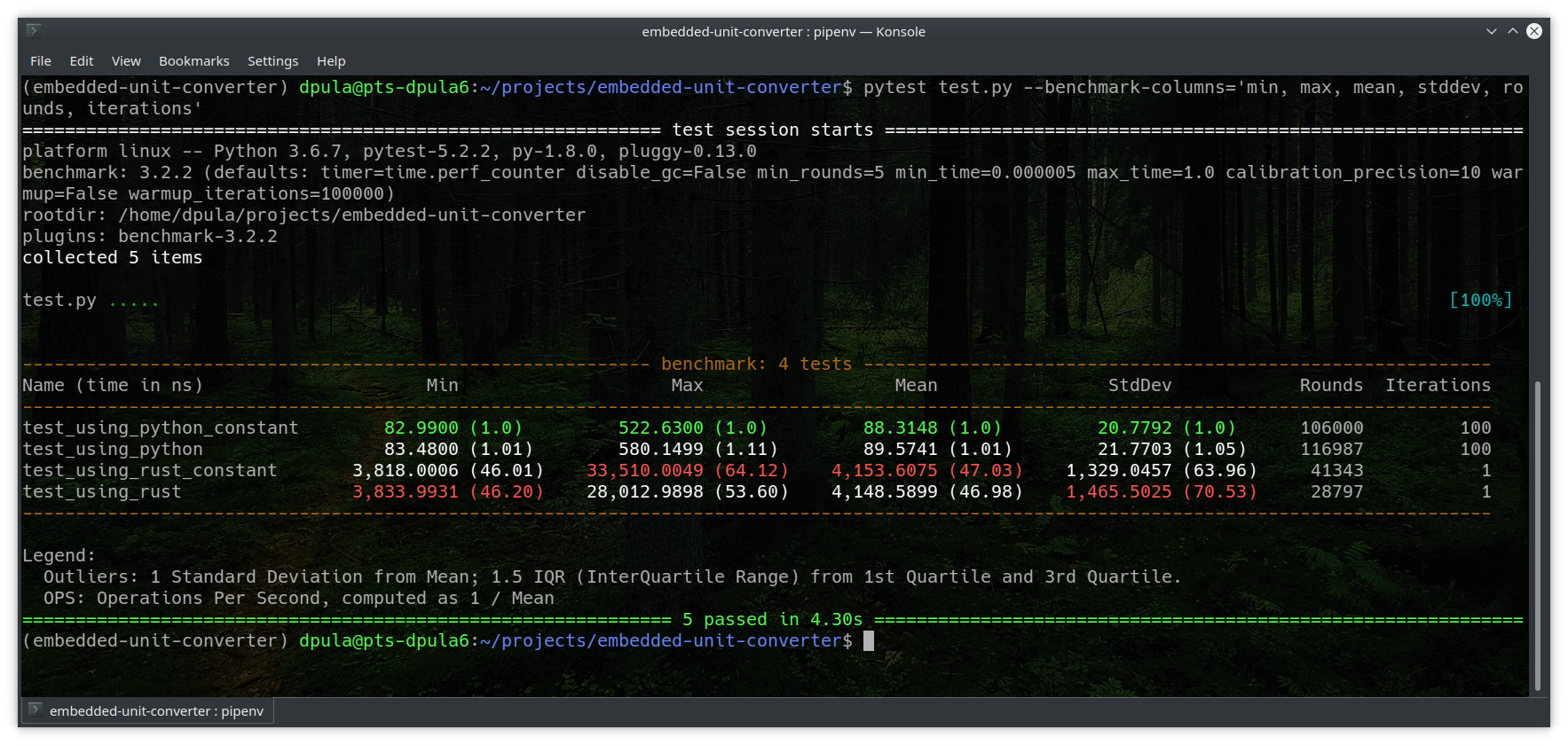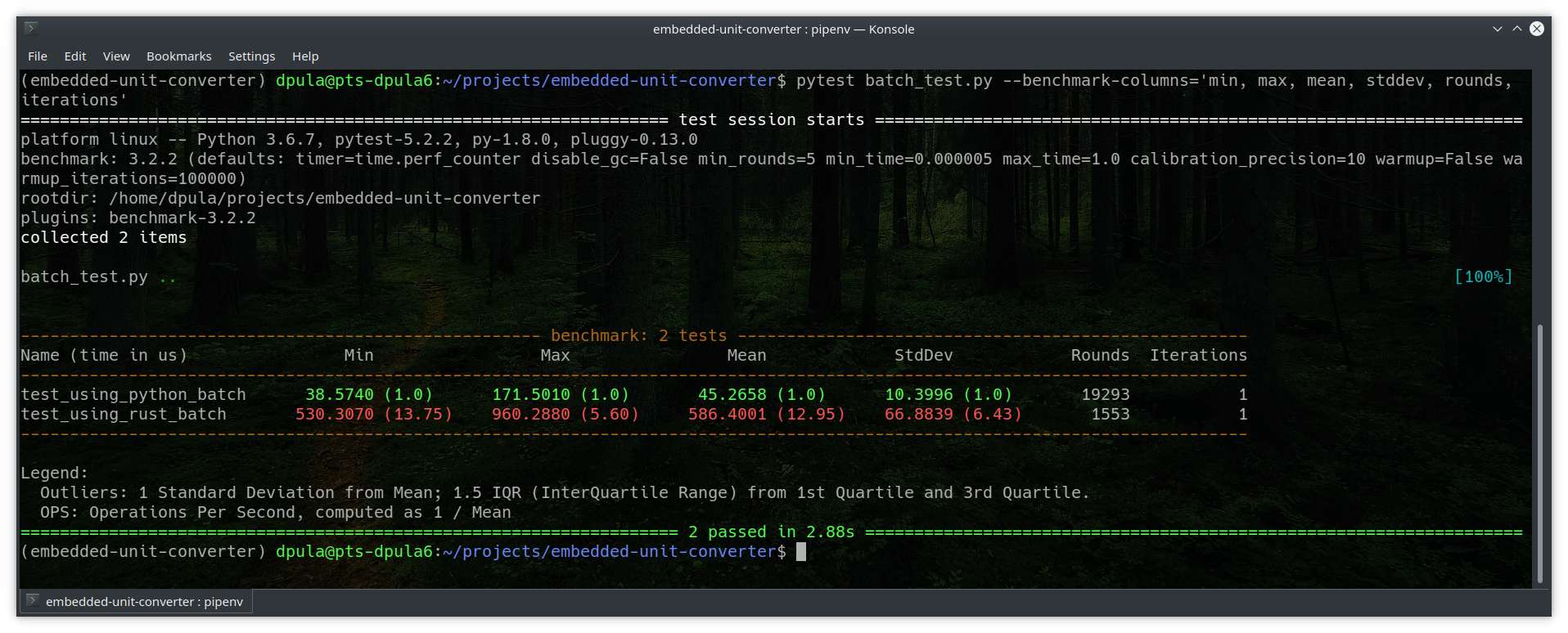Rust Accelerated Pythons
Presented by Dorian Puła @ PyCon Canada 2019
Photo © 2010 Colin - https://www.flickr.com/photos/48625620@N00/4446021223/

+
Who am I?
Dorian Puła (@dorianpula)
Software Developer @ Points
- Develops loyalty program e-commerce platforms.
- Micro-services APIs, web frontend + DevOps tooling

Open Source
- Contributer to Ansible, Fabric, CPython + Flask.
- Rookeries (Markdown and Web Component static site generator powered by Rust).
- PyCon US/Canada speaker + sprints coordinator.
- Working to improve developer experience for Devs and Ops on Linux with Python + Rust through writing about and coding on tooling.
Why Extensions and Why Rust?
Photo © 2010 Colin - https://www.flickr.com/photos/48625620@N00/4446021223/
Use Cases for Writing Extensions
- Performance:
- Python only as fast its interpreter.
- Or as fast as its C-based libraries (e.g. numpy).
-
Python is 70x more energy intensive than in C.
- Equivalent code benchmarked for power consumption over time (R. Periera et al. 2017).
- Interoperability with Existing Libraries:
- Leveraging existing native libraries built over the past few decades with C libraries on a stable ABI.
- Many interesting libraries like SDL, Boost, or database drivers.
Why Rust?
- Features:
- Memory Safety Guarantees in the Compiler.
- Few devs can write safe non-trivial C/C++ code.
- Ergonomics in Language
- Easier for a non-system dev to learn than C++.
- Language based on Python-like syntax, years of C++ experience, and language design research.
- Powerful tooling and workflow via cargo.
- Efficient on par with C: Rust 1.03x vs C++ 1.33x.
- Memory Safety Guarantees in the Compiler.
An innovative systems-level language that helps
with writing memory safe, fast and reliable code.
Example Library Binding
Photo © 2010 Colin - https://www.flickr.com/photos/48625620@N00/4446021223/
Unit Conversion Calculator Example
- Need fast conversions from Celsius to Fahrenheit.
- Feature of a Django based search engine for developers to rival the functionality of DuckDuckGo, Google, Bing, and others.
- The unit conversion needs to be driven from Python.
- Small proof of concept for more complex enhanced searches like exchange rates of real and virtual currencies.
- Rust's WebAssembly tooling interesting for cross backend/web frontend applications.
Rust + Python Code
Rust
fn convert_to_fahrenheit(celsius: f32) -> f32 {
celsius * 1.8 + 32.0
}
#[cfg(test)]
mod tests {
use super::{convert_to_fahrenheit, Temperature};
#[test]
fn conversion_celsius_to_fahrenheit() {
assert_eq!(convert_to_fahrenheit(25.0), 77.0);
}
}
Python
import unit_converter
def test_using_unit_converter():
assert unit_converter.convert_to_fahrenheit(25.0) == 77.0
Rust Structs / Python Objects
Rust
struct Temperature {
celsius: f32,
}
impl Temperature {
fn to_fahrenheit(&self) -> f32 {
self.celsius * 1.8 + 32.0
}
fn windchill(&self, wind_speed_kph: f32) -> f32 {
13.12 + (0.6215 * self.celsius) - (11.37 * wind_speed_kph.powf(0.16))
+ (0.3965 * self.celsius * wind_speed_kph.powf(0.16))
}
}Python
import unit_converter
def test_using_unit_converter():
temperature = unit_converter.Temperature(25.0)
assert temperature.to_fahrenheit() == 77.0
def test_windchill():
temperature = unit_converter.Temperature(-20.0)
assert round(temperature.windchill(32.0), 1) == -32.9
Binding Between Python + Rust
Photo © 2010 Colin - https://www.flickr.com/photos/48625620@N00/4446021223/
How Python Bindings Work
- Translates code on the binary level.
- Not using RPC, JSON, or other serialization.
- Code needs memory alignment to be callable.
- Rust & C++ both do name mangling. Need to use a C style library for binding.
- Works with CPython's internal representation
- Calling Py* methods like PyModule_AddObject.
- Manage reference counting of objects.
- Acquiring / releasing the GIL.
- Override/implement operators.
- Translate between types.
- Non-trivial work that you don't want to do by hand.
PyO3 - Intro + Installation
- PyO3
- Bi-directional bindings between Rust + Python.
- Use Rust Nightly release for procedural macros that wrap functions, and structures.
- Create a library project using cargo new lib.
-
Add pyo3 dependencies to Cargo.toml
- Lib dependencies: Python 3.5+ or PyPy.
- Maturin
- Tooling for building Python packages from Rust.
-
pip install maturin
Wiring up the Rust Code
#![feature(specialization)]
#[macro_use] extern crate pyo3;
use pyo3::prelude::*;
#[pyfunction]
pub fn convert_celsius_to_fahrenheit(celsius: f32) -> f32 {
celsius * 1.8 + 32.0
}
#[pymodule]
fn unit_converter(_py: Python, module: &PyModule) -> PyResult<()> {
module.add_wrapped(wrap_pyfunction!(convert_celsius_to_fahrenheit))?;
Ok(())
}
// ... Test code below ...
Wiring up the Rust Structs
#![feature(specialization)]
#[macro_use]
extern crate pyo3;
use pyo3::prelude::*;
#[pyclass(module = "unit_converter")]
struct Temperature { celsius: f32 }
#[pymethods]
impl Temperature {
#[new]
fn new(obj: &PyRawObject, temperature: f32) {
obj.init(
Temperature { celsius: temperature }
);
}
fn to_fahrenheit(&self) -> f32 { self.celsius * 1.8 + 32.0 }
// Windchill function truncated for clarity.
}
#[pymodule]
fn unit_converter(_py: Python, module: &PyModule) -> PyResult<()> {
module.add_class::<Temperature>()?;
Ok(())
}
Creating a Python Package from a Rust Bindings Crate
- maturin
- maturin develop - for local builds
- maturin publish - for releasing a PyPI package.
- maturin build --release - for an optimized build installed locally.
Demo
Embedded Unit Conversion Example:
Performance Benchmarks
Photo © 2010 Colin - https://www.flickr.com/photos/48625620@N00/4446021223/
Benchmarks
Using pytest-benchmark to compare against a Python implementation...

- Why would the Rust version be significantly slower?
- Example of why you need to measure before saying an approach is more optimized than another.
Batch Benchmarks
What about batching the calculations?

- Much better but crossing FFI boundary is expensive.
- Batching is how numpy increases its performance.
Better Benchmark Examples
PyO3 has a better example with parallel word count.
- Sequential Rust - 2x faster than sequential Python.
- Parallel Rust using threads - 6x faster.
----------------------------------------------------------------------------------------------------
Name (time in us) Min Max Mean
----------------------------------------------------------------------------------------------------
test_pure_python_once_numba 292.0990 (1.0) 317.7590 (1.0) 296.7477 (1.0)
test_numpy_numba 326.2470 (1.12) 526.1350 (1.66) 338.1704 (1.14)
test_rust_bytes_once 336.0620 (1.15) 1,053.0090 (3.31) 342.5122 (1.15)
test_c_swig_bytes_once 375.6310 (1.29) 1,389.9070 (4.37) 388.9181 (1.31)
test_rust_once 986.0360 (3.38) 2,498.5850 (7.86) 1,006.5819 (3.39)
test_numpy 1,137.1750 (3.89) 2,000.5430 (6.30) 1,167.2551 (3.93)
test_rust 2,555.1400 (8.75) 3,645.3900 (11.47) 2,592.0419 (8.73)
test_regex 22,597.1750 (77.36) 25,027.2820 (78.76) 22,851.8456 (77.01)
test_pure_python_once 32,418.8830 (110.99) 34,818.0800 (109.57) 32,756.3244 (110.38)
test_pure_python 43,823.5140 (150.03) 45,961.8460 (144.64) 44,367.1028 (149.51)
test_python_comprehension 46,360.1640 (158.71) 50,578.1740 (159.17) 46,986.8058 (158.34)
test_itertools 49,080.8640 (168.03) 51,016.5230 (160.55) 49,405.2562 (166.49)
----------------------------------------------------------------------------------------------------
Counting double letter pairings example more thorough
Summary
Photo © 2010 Colin - https://www.flickr.com/photos/48625620@N00/4446021223/
Using PyO3 + Rust + Python 3
- Great experience writing in Rust.
- Great tooling, documentation and community.
- Innovative language design.
- Expect some struggles learning about memory management, traits, and lifetimes.
- Ultimately an empowering experience.
- PyO3 makes native binding creation easy.
- Maturin streamlines the packaging aspect.
- Consider it as another tool to improve performance.
- Check with benchmarks first.
Further Reading
- Rust
- PyO3:
- PyO3 Documentation: https://pyo3.rs
- pyo3/pyo3 repo @ GitHub
- maturin for building Python packages from Rust crates
- Examples:
- Energy Efficiency across Programming Languages study (R. Periera et al, 2017)
Thanks!

Questions?
